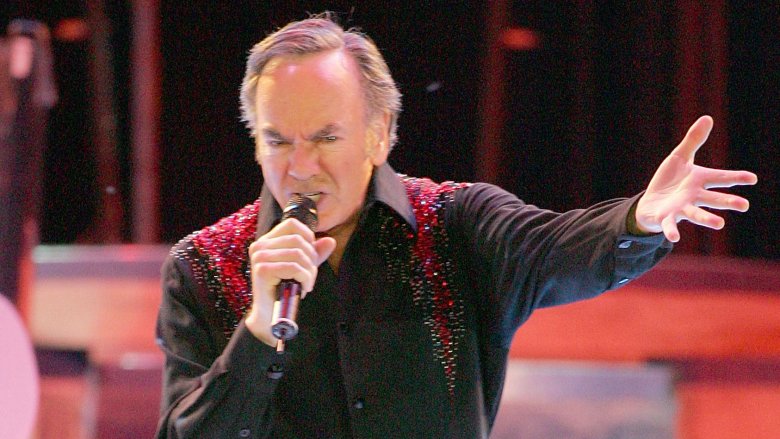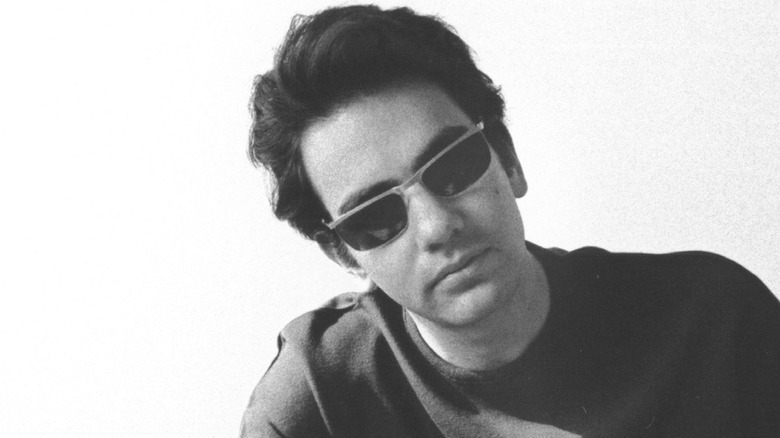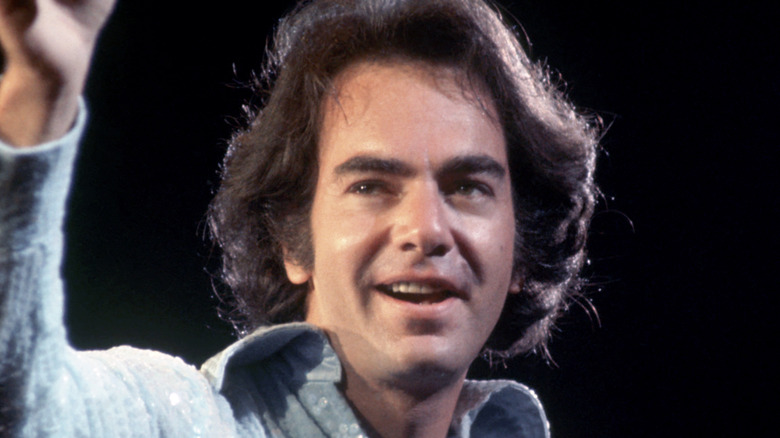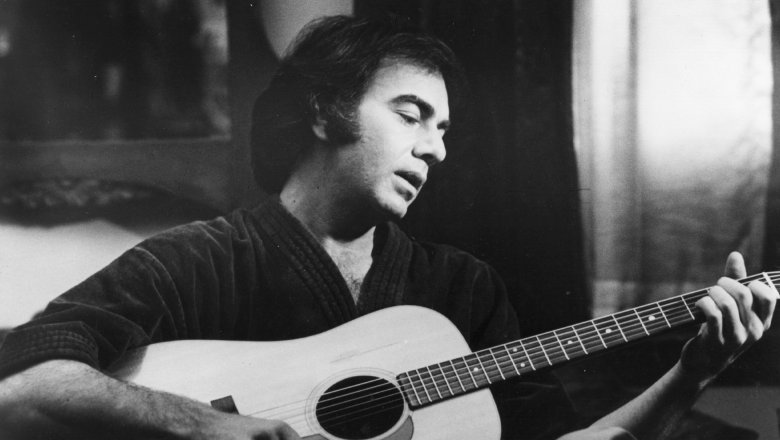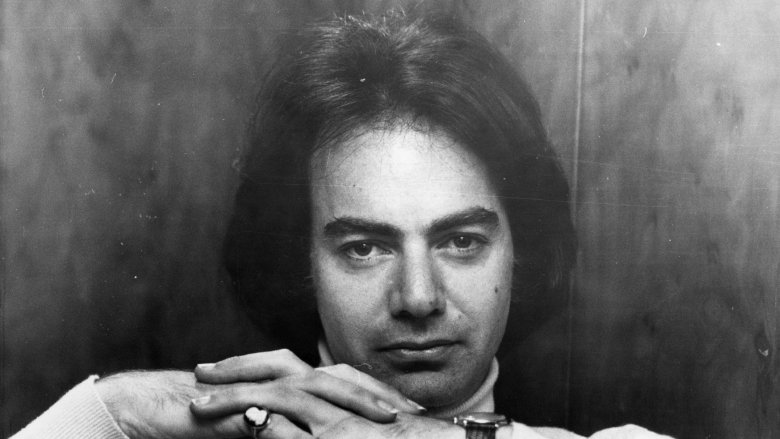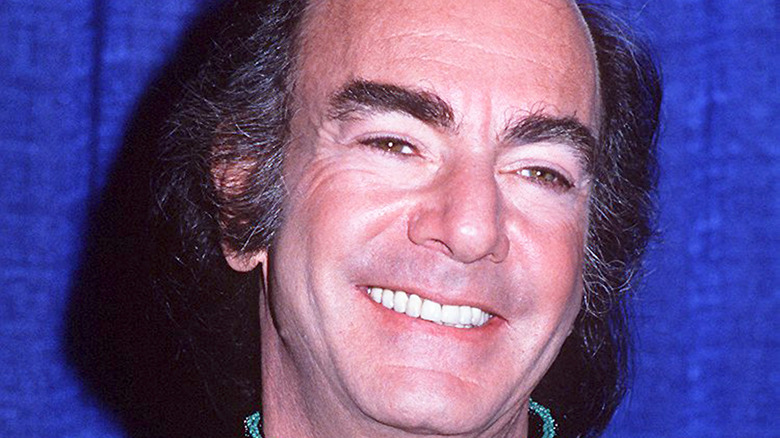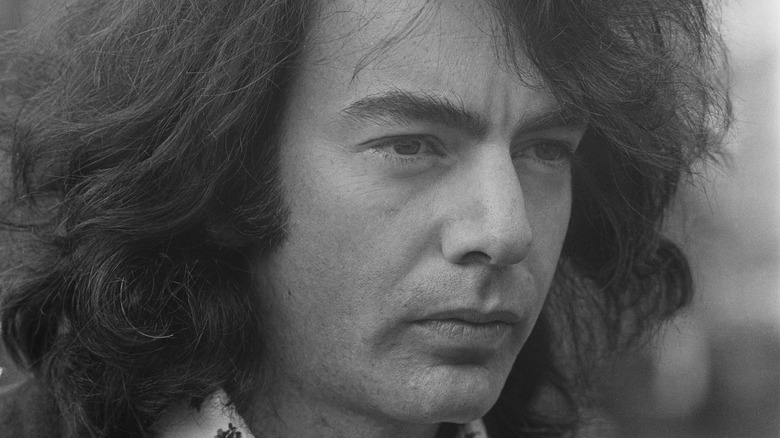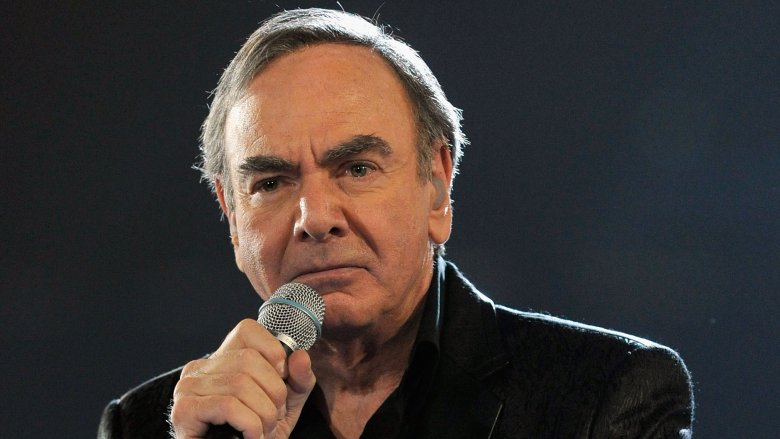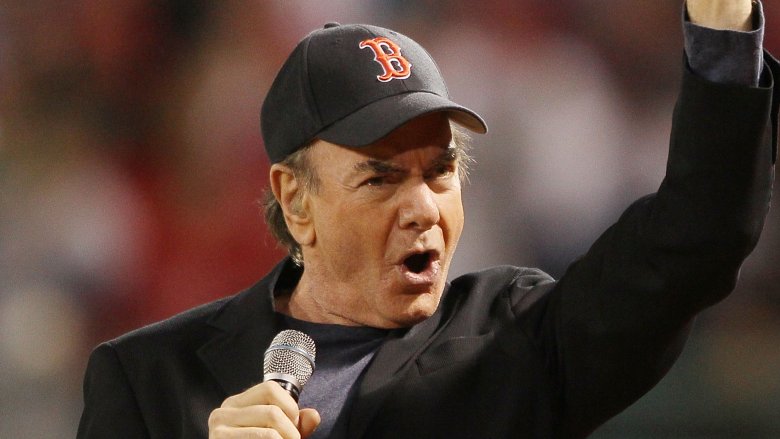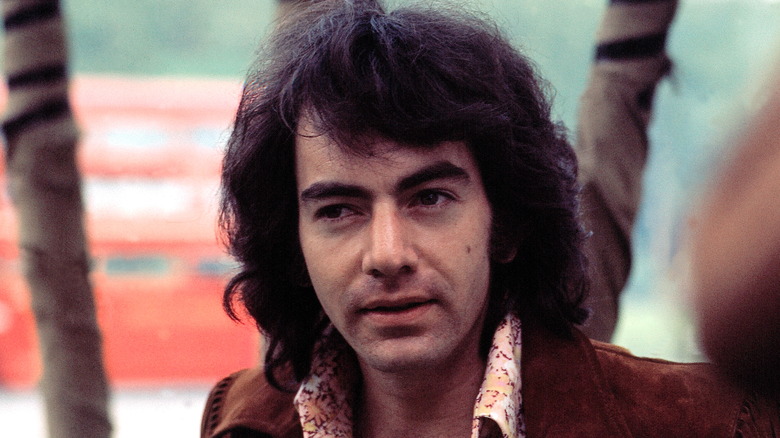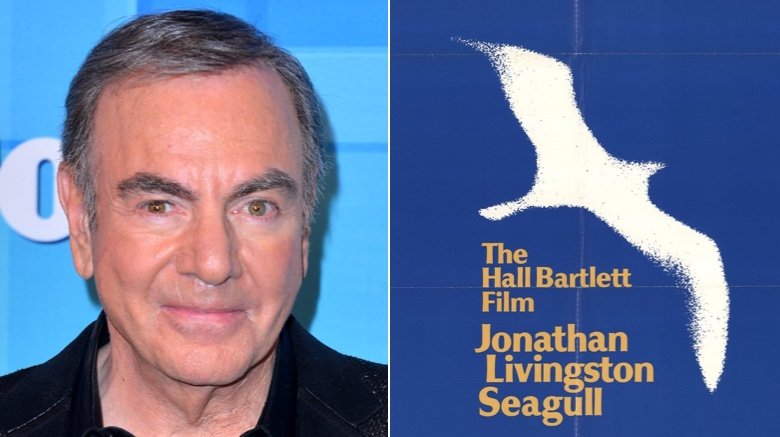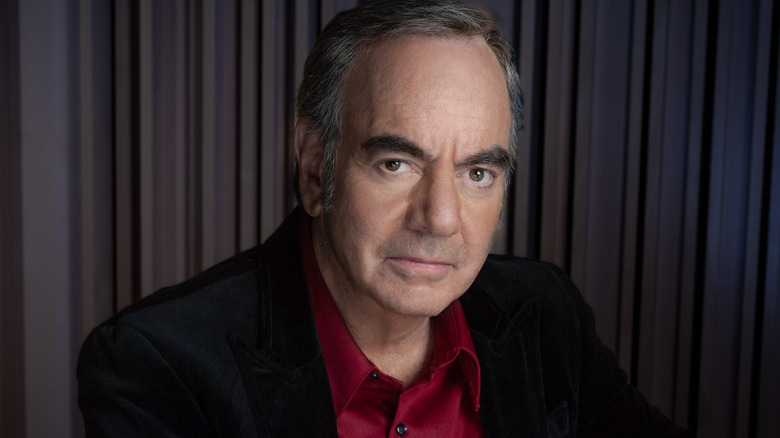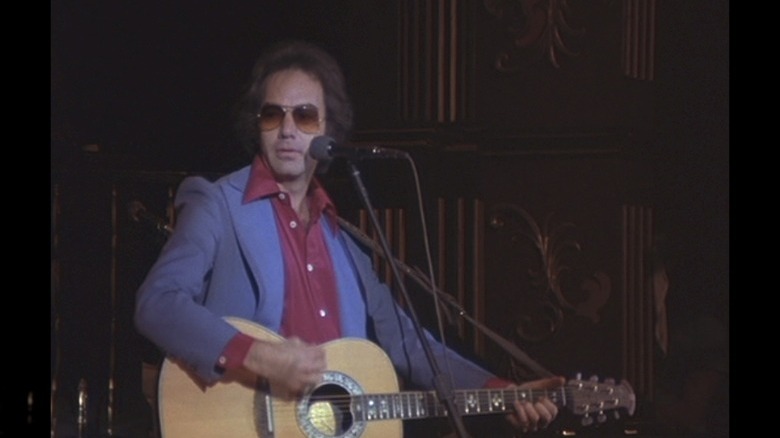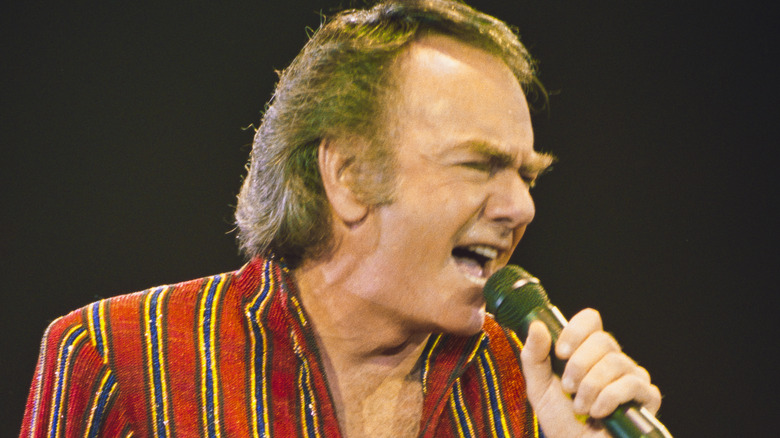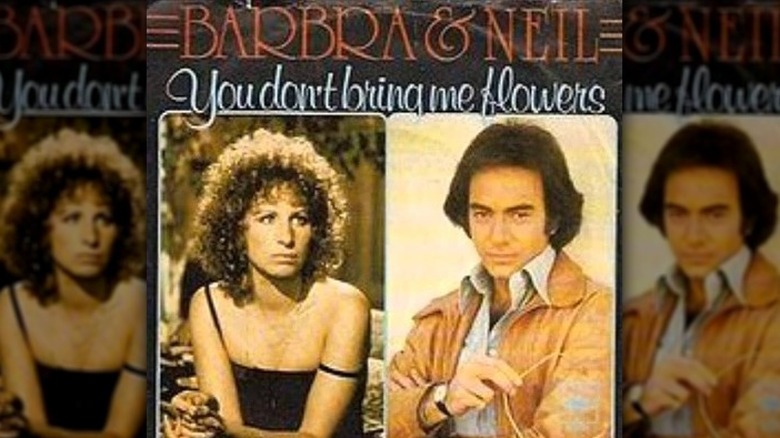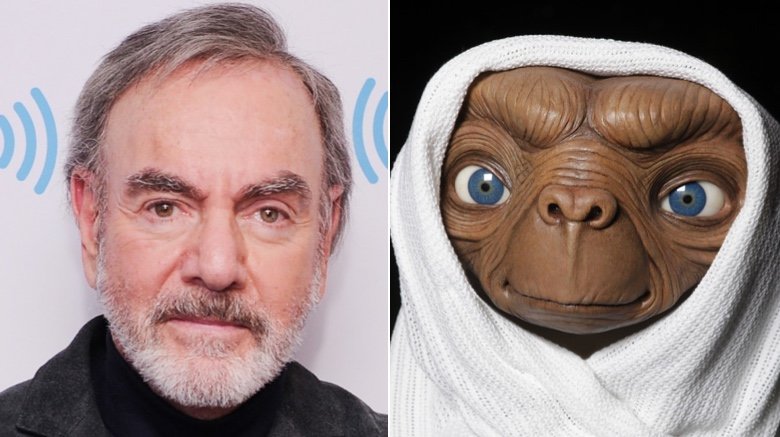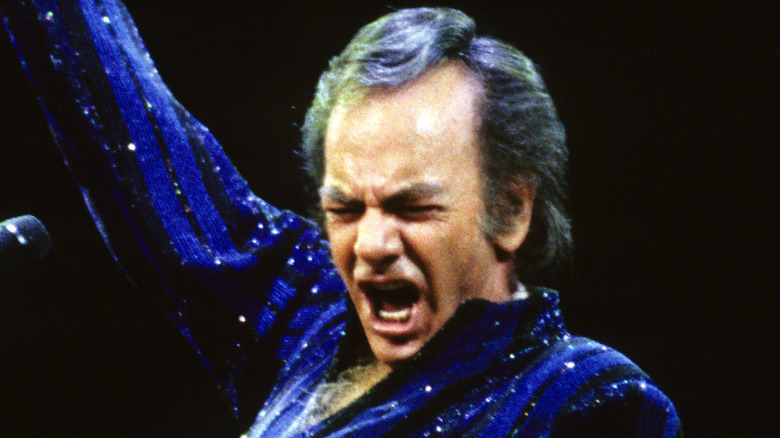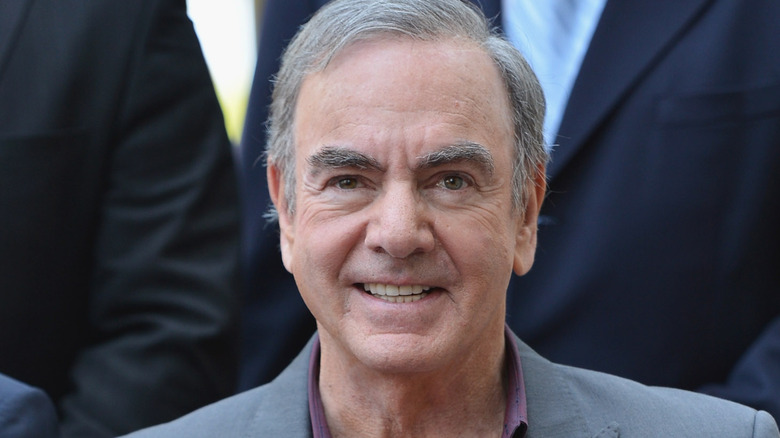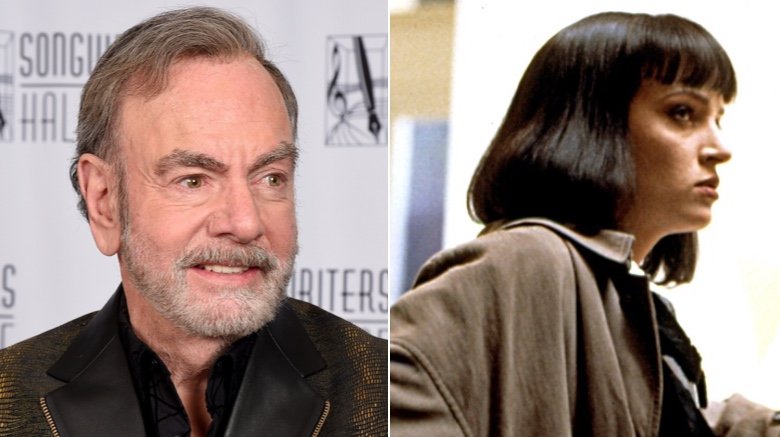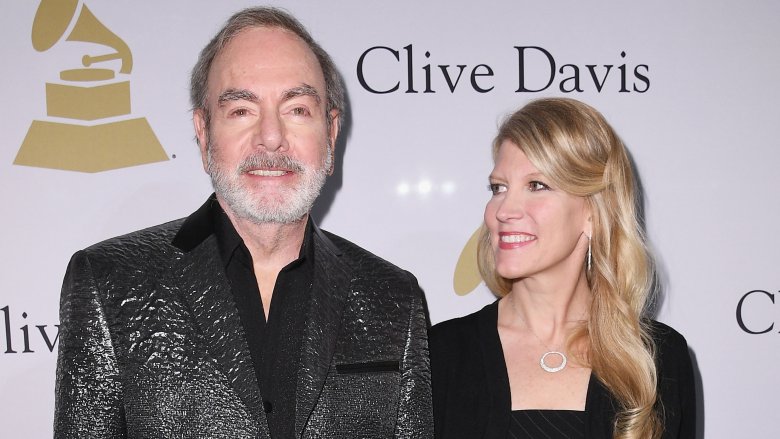The Untold Truth Of Neil Diamond
Only a handful of musicians have sold more records than Neil Diamond. He ranks with Elvis Presley, the Beatles, and Madonna in terms of commercial, unit-moving success. That's because he's been actively performing and recording since the mid-1960s. While he started off as a pop songwriter, Diamond realized he had a knack for singing his own songs. Millions agreed, making classics out of Diamond's many hit songs, like "Sweet Caroline," Solitary Man," "Cracklin' Rosie," "America," and "Girl, You'll Be a Woman Soon."
While he hasn't had a chart-topper in a while, Neil Diamond has continued to release albums in multiple styles of music and relentlessly tour to perform his beloved catalog for several generations of fans. He's in his late 70s now, and winding down a long, lucrative, and unlikely career, so here's a look into the colorful life of the man who's got the way to move you and groove you, the king of soft rock, the "Jewish Elvis" himself, Neil Diamond.
He could beat you in a sword fight
This should come as no surprise, but one of Neil Diamond's main extracurricular activities in high school was singing in the chorus, along with 99 other performers who did not grow up to be Neil Diamond. He was a well-rounded kid, though, balancing the arts with the athletics. He was a fencer, and apparently so good with an epee that he won a scholarship to study at New York University and be on the school's top-shelf fencing squad.
While Diamond studied at NYU (he was pre-med, focusing on biology and chemistry), the fencing team did very well. The school won two national championships and three intercollegiate titles with the United States Fencing Association. "We had the greatest fencing team in the country," Diamond is quoted as saying in "Neil Diamond: His Life, His Music, His Passion." However, Diamond didn't lose sight of the team. "I was proud to be the ninth man on a nine-man team."
Neil Diamond wanted to cure cancer
Raised in Brooklyn, Neil Diamond attended college across town in New York City, at the prestigious New York University. A star student athlete, his tuition was paid for by a fencing scholarship, leaving Diamond able to get into a graduate school and a professional path to pursue what he thought at the time was his passion: oncology. "I actually wanted to go to medical school. I actually wanted to be a laboratory biologist," Diamond said on "Larry King Live" in 2003. That career choice was inspired by a family tragedy — cancer killed his grandmother. "I was always very good at the sciences. And I thought I would go and try and discover the cure for cancer."
What stood in the way for Diamond: The difficulty of necessary organic chemistry courses. His grades in that clutch subject were too "terrible" to pursue research medicine after his undergraduate years. But toward the end of college, Diamond signed a deal to write songs for a music publisher, securing himself an entry point into a career built around his other passion: composing songs.
His first song got him married but wasn't released for years
Well before he started filling stadiums and scaling the pop chart as a performer, Neil Diamond was a songwriter. It's a craft he first explored at the age of 16 while growing up in Brooklyn, when someone gave Diamond a used nine-dollar guitar for his birthday. He'd take some lessons on the instrument, and after learning to play it properly, he gave composing a try at age 17.
His inspiration for his first fully realized original song: his high-school girlfriend, Jaye Posner. "I really wanted to impress her but I couldn't afford to buy her a gift," Diamond recalled in "Neil Diamond: His Life, His Music, His Passion." "So I wrote a song called 'Hear Them Bells,' which basically was a song saying, 'Will you marry me?'" "Hear Them Bells" did the trick — Diamond and Posner married in the early '60s (and divorced by the end of the decade). The tune that put Diamond on the professional songwriter track remained a private piece of early work for decades, until the musician recorded it and released it on his career-spanning box set "In My Lifetime" in 1996.
He tried to make a dollar out of 35 cents
"Tin Pan Alley" is a legendary institution in the history of American music. It's a nickname for an area of New York where a number of record labels and music publishers had their offices in the early to mid-20th century. These folks hired songwriters to sit in offices all day and churn out songs. Although he needed just 10 credits to graduate college, Neil Diamond dropped out of school, headed to Tin Pan Alley, and got a 16-week gig at $50 each week with Sunbeam Music.
When his contract ended, it wasn't renewed, but based on the strength of his voice on the demos of songs he'd written, Columbia Records hired him to make a record. Unfortunately, it didn't really go anywhere, so Diamond bounced around various music publishers for seven years, barely getting by. "I had very few things that were recorded even," Diamond told Rolling Stone. "I'd spent a lot of time on lyrics, and they were looking for hooks and I didn't really understand the nature of that." He'd sell a song occasionally, forcing himself to severely ration his funds. For "a year," he says, he spent 35 cents a day on food — 23 cents for a sandwich, 10 cents for a Coke, and two cents for a piece of candy.
Eventually, Diamond got the knack for songwriting, and the attention of the music industry. By 1966, he was on his way to superstardom.
The inspiration behind Solitary Man will not surprise you
No matter the style — pop, rock, adult contemporary, country, or folk — Neil Diamond writes and sings songs of love and romance, of heartbreak and triumph. Of course he's inspired by his life a little bit, but his compositions are about universal themes. He's not exactly Stevie Nicks or a rapper, penning song after song explicitly and exclusively about himself and his experiences ... right? Diamond probably believed that about himself, too, until he had a breakthrough in therapy.
In 1966, Diamond released "Solitary Man," his first single for Bang Records (and a song he wrote himself). His first performing success, it reached the lower rungs of the Hot 100, peaking at No. 55. (After Diamond's popularity grew in subsequent years, he re-released "Solitary Man" in 1970, and it hit No. 21 that time.) After the song's heat came and went, Diamond realized, with the help of a psychiatrist, that the song was about his lonely years of hustling and struggling. "After four years of Freudian analysis I realized I had written 'Solitary Man' about myself," Diamond said to fan site I Am...I Said.
He left his sketchy record label
After writing songs for other artists, Neil Diamond signed his first recording contract in the mid-1960s. His label: Bang Records, an operation Diamond believes was affiliated with New York's criminal underworld. "To start a tiny label like that they had to have some kind of backing and whether it was kosher or not, I really can't say," Diamond told the Irish Independent. "There were some guys with broken noses who were helping to get the records played." When Bang head Bert Berns uncovered an operation in New York selling counterfeit copies of Diamond's early hit records, the perpetrators reportedly wound up with broken legs.
Despite the sense of both imminent danger and maybe some loyalty to the company that made him a singing sensation (Bang released Diamond's first nine charting singles, including "Cherry, Cherry" and "Girl, You'll Be a Woman Soon"), he decided to leave the label in 1967 (and join Uni Records the next year). "Bang Records wanted me to continue doing things like 'Cherry Cherry,' but I wanted to be more creative. They weren't happy with that," Diamond explained. "So we locked horns and I finally said, 'that's it, I'm gone, do what you will.' Then I got calls from people I know, saying, 'the FBI has word that the Mafia is coming after you, be careful.'"
Diamond started carrying a loaded handgun whenever he was in New York, a habit he was eventually able to discontinue. Months after Diamond's exit in 1967, Berns died at age 38, and in March 1968, a court battle finally freed him from his contract with Bang Records.
'Cherry, Cherry' was rough and ready
Parallel to his work as a writer of songs for other acts, Neil Diamond tried to get his singing career going in the early 1960s, releasing a string of flop singles. He didn't score his first top 40 hit until 1966, with the No. 6 smash "Cherry, Cherry." The song took Diamond's stardom to the next level, and it wasn't even something he considered too precious or special at first, nor did it wind up a particularly carefully made product.
Songwriting duo Jeff Barry and Ellie Greenwich helped Diamond hone his skills and gave him his first breaks in the music industry. Overhearing Diamond casually messing around with a bouncy guitar riff one day in the mid-1960s, Barry told the singer-songwriter to flesh it out into a whole song. Diamond did, crafting a pop tune called "Money, Money." But Bert Berns, head of Diamond's label, Bang Records, rejected the idea, telling him to rewrite the song into something with more youth appeal. Diamond turned "Money, Money" into "Cherry, Cherry" and recorded a bare-bones demo, using hand claps to mark time, intending to replace them in the final mix with drums. Bang Records didn't see the point and the infectious hand claps stayed in, and so the publicly released version of "Cherry, Cherry" is Diamond's demo.
Neil Diamond would be a great stage name if it weren't real
Never mind the subjective nature of judging the man's music; we can all admit that "Neil Diamond" is a marvelous name. It's a fantastic name for a legendary singer who holds court before giant arenas full of people, bringing down the house with classic hits while wearing sparkly clothes. In other words, "Neil Diamond" perfectly describes Neil Diamond. It's one of the great performer names, right up there with Lady Gaga and Snoop Dogg. And yet, surprisingly, "Neil Diamond" isn't a stage name at all.
Like Prince, Cher, and Madonna, this pop star chose to hit the scene with the name his momma gave him. But he almost didn't. In a 2014 Ask Me Anything session on Reddit, Diamond revealed that he considered some stage names early in his career. "Neil Diamond may sound cool now," he said, but at the time, "it was just my name and pretty boring." He said he "chickened out for personal reasons" and didn't use the two finalists he'd chosen: Noah Kaminsky ("which had biblical underpinnings and great character") and Ice Charry ("which I thought was pure rock & roll"). A guy named Charry singing "Cherry, Cherry!" How very (very) ... lame.
Why Sweet Caroline is so good, so good, so good
"Sweet Caroline" isn't Neil Diamond's biggest hit (it peaked at No. 4 on the Hot 100, unlike his No. 1 hits "Song Sung Blue" and "Cracklin' Rosie," for example), but it's probably his best-known now, thanks to its use as a singalong at sporting events. A bit of oft-repeated lore about the "Daydream Believer" soundalike is that Diamond wrote it about Caroline Kennedy, daughter of President John F. Kennedy. Except that if Diamond wrote the tune in the late '60s, Caroline Kennedy would've been about 11 years old. What gives?
"I was writing a song in Memphis, Tennessee, for a session," Diamond told Today in 2014. "I needed a three-syllable name." He actually wrote the song about his then-wife: "... her name was Marcia — and I couldn't get a 'Marcia' rhyme." So he plugged in the name Caroline instead, which he knew because of the Kennedys.
Why is "Sweet Caroline" so connected to sports, particularly the Boston Red Sox? It's actually relatively recent. The song plays at Fenway Park before the bottom of the eighth inning at every home game, and it all started with Amy Tobey, the stadium's music director from 1998 to 2004. Responsible for choosing songs to play over the P.A., Tobey had heard "Sweet Caroline" at another sporting event, and played it at Fenway because it was upbeat. Soon Tobey started playing it only if the Sox were winning, and it became a good luck charm ... and eventually a tradition.
'Brooklyn Roads' put Neil Diamond on the road to artistic satisfaction
A smash hit after a series of failures, "Cherry, Cherry" was such a massive and satisfying success for Neil Diamond that, after it made him a star, he tried to recreate the song to recapture its magic. "I was the guy who was trying to reinvent 'Cherry, Cherry' again and again, and not doing a very good job," Diamond told Billboard. Case in point: Diamond's immediate post-"Cherry, Cherry" singles are similarly catchy, populist pop-rock nuggets: "Kentucky Woman," "Red, Red Wine," "Thank the Lord for the Night Time," and "Girl, You'll Be a Woman Soon." All of those reached the Billboard Hot 100, but none matched or surpassed the No. 6 peak of "Cherry, Cherry."
Diamond knew he needed to make a change, both for himself and for his audience. And so he wrote the introspective, intimate ballad "Brooklyn Roads" in 1968, a song in which he reflected on his life and place in the world. It became a transitional jumping-off point for Diamond's song-craft. "After 'Brooklyn Roads' my whole story, my whole life became a place that I could write about in my songs and my life became the songs," he said.
Neil was not a fan of making movies
Eventually, most huge music stars head to the movies. The Beatles had their "A Hard Day's Night," Whitney Houston made "The Bodyguard," and Michael Jackson was in "The Wiz." Movies just weren't Neil Diamond's thing, though, as evidenced by his experience with the 1973 adaptation of Richard Bach's spiritual/New Age bestseller "Jonathan Livingston Seagull."
Diamond wrote and recorded the soundtrack for the film about a bird's search for the meaning of life (the '70s, man), and it did not go well. He and Bach sued the film's director/producer Hall Bartlett over what they both felt were egregious, if not unauthorized and ill-advised, changes to the plot and to Diamond's songs. "After 'Jonathan,'" Diamond told People, "I vowed never to get involved in a movie again unless I had complete control." And he kept his word, until he had a chance to star in a movie, the 1980 critical flop "The Jazz Singer."
He's taken extensive mental health breaks
The standard model for most pop singers and rock stars is a grueling one: record an album, embark on an extensive concert tour to promote that album, and repeat the cycle every one to two years. Defying that, and never losing much of the stature or fanbase he'd worked so hard to acquire, Neil Diamond sought work-life balance long before that was a well-known concept.
In 1970, Diamond was the No. 1 male performer in the United States, in the midst of a prolific and successful period that saw the release of a slew of now-classic hits, including "Sweet Caroline," "Solitary Man," "Cracklin' Rose," "I Am...I Said," and "Song Sung Blue." Toward the end of 1972, Diamond completed a tour of Europe and decided to pause performing to devote himself to scoring the film "Jonathan Livingston Seagull," and to just take a break from the grind. Over four years, Diamond got "to know myself and my family, to write, to explore different kinds of music without the distraction of having to tour," he told The Washington Post. "I came back with a great deal of confidence. I wasn't as insecure about myself as a person."
Understanding the value of time off, Diamond took another self-imposed recess in March 1985, following the death of his father. "I didn't do much work for eight or nine months after that," he said.
He wasn't entirely welcome at The Last Waltz
Neil Diamond scored hit records in the '60s, but he's not really considered a '60s act, not like, say, Bob Dylan or the Band. And yet, there's Neil Diamond on stage in "The Last Waltz," the Martin Scorsese-directed concert film of the Band's star-studded (supposedly) final performance in 1976. Paying tribute to the Band were acts like Dylan, Eric Clapton, Neil Young, Joni Mitchell, and Van Morrison. Diamond is an odd addition, and one that wasn't necessarily welcomed.
"When I heard that Neil Diamond was going to play, I asked, 'What the hell does Neil Diamond have to do with us?" Band drummer Levon Helm said in his autobiography "This Wheel's On Fire" (via Ultimate Classic Rock). Band singer Robbie Robertson, who'd just produced Diamond's album "Beautiful Noise," explained. "Neil is like Tin Pan Alley," Helm says Robertson iterated. "That '50s, Brill Building scene" where Diamond once toiled as a pop songwriter.
Other supposedly cooler musicians remained unconvinced. According to rock lore, Young approached Diamond and sarcastically introduced himself as Neil Sedaka. Diamond told Rolling Stone about the icy reception Dylan gave him when he tried to relieve the tension. "He was tuning his guitar and I came over to him and I said, 'You know, Bob, those are really my people out there.' He kind of looked at me quizzically. I said it as a joke, but I think it spurred him a little bit and he gave a hell of a performance," Diamond said.
Neil Diamond isn't cool, but that's cool with Neil Diamond
As evidenced by the antipathy and hostility expressed by the edgier rock acts in "The Last Waltz," Neil Diamond has struggled to convince the world that he's hip. Sure, he churned out hits in the countercultural-dominant late 1960s and 1970s, but over time, it became more likely that a new Diamond song would make a bigger impact on the adult contemporary chart than the pop or rock lists.
Diamond made peace with his lack of coolness long ago."It didn't relate to what I was trying to do, which was essentially to try and be Alan Jay Lerner or George Gershwin," Diamond told Rolling Stone. "'Hip' was something frivolous people had time to be. I didn't have time to be hip and with it and groovy. I was dealing with something that was much more important: with my life and trying to write songs that had substance."
Diamond further differentiated himself from the drug-embracing counterculture with his staunchly anti-drug 1968 recording "The Pot Smoker's Song." "So to the hip community, you know, it was more evidence that Neil Diamond was not one of their kind of guys. It was genuine; it was heartfelt," he said in David Wild's "He Is... I Say." "But it also confirmed a lot of people's feeling that I wasn't hip."
He didn't bring Barbra Streisand flowers in high school, either
Neil Diamond scored a No. 1 hit single in 1978 with "You Don't Bring Me Flowers," a gut-wrenching song about divorce. Working with Alan and Marilyn Bergman, Diamond initially co-wrote "You Don't Bring Me Flowers" as a 45-second track for use in a TV project that ultimately changed course. So, he made it into a full-length song and released it.
In November 1977, Louisville, Kentucky, disc jockey Gary Guthrie got a listen. "I had heard Diamond sing this song and noticed the response it evoked in my wife and other women," Guthrie said to the Courier-Journal. "But I kept thinking there was something missing." When Barbra Streisand released her version of the song in early 1978, it struck Guthrie that it ought to be a duet. So he spliced the two versions together and played his ad hoc duet on the air, where it became a smash. The mix got some attention in radio industry publications, and so other stations started playing it, too. The fake duet got so popular that Diamond and Streisand recorded an "official" version together.
And in a weird coincidence, it turned out Streisand and Diamond had some history already. Not from the music industry or a fizzled romance: They went to Erasmus Hall High School together. "I didn't know Barbra at all," Neil told Larry King, although both of them sang in the school chorus at the same time.
Being inspired by E.T. became an expensive mistake
"E.T.: The Extra-Terrestrial" was nothing short of a pop culture phenomenon. The 1982 movie about a little boy named Elliott and the lost, gentle alien he befriends became the top-grossing film of all time, moved millions in merchandise, and caused sales of Reese's Pieces to skyrocket. An official soundtrack album hit stores, too, featuring John Williams' score, along with narrative storybook-style segments provided by Michael Jackson, who also sings in a song called "Someone in the Dark."
So for a while, "E.T." was on a lot of people's minds, including those of Neil Diamond and songwriters Carole Bayer Sager and Burt Bacharach. The three all saw "E.T." together and were so inspired they composed a song called "Heartlight," evoking images of the little alien man's empathy-powered, glowing chest. "E.T." fever propelled the song to No. 5 on the pop chart (Diamond's last top 40 hit to date). One problem: copyright infringement. The song is so obviously about "E.T." (sample lyrics: "he's lookin' for home" and "come back again, I want you to stay next time" and "turn on your heartlight") that it angered the film's rights-holders, Universal. According to Serene Dominic's "Burt Bacharach, Song by Song," Diamond and his cohorts had to pay the studio $25,000 to cash in on "E.T." and avoid further legal action.
He could have been a movie star
Neil Diamond only ever starred in one major movie, 1980's "The Jazz Singer." But it wasn't for a lack of interest on Hollywood's part. In the late 1960s, Diamond wanted to act, and he appeared as himself on an episode of "Mannix," which landed him a screen test for Universal Studios. In 1970, movie producer Marvin Worth asked Diamond if he had any interest in playing the late, legendary, scandalous comic Lenny Bruce in a biopic.
Diamond wanted the role, and performed some stand-up comedy in Hollywood to get into character. A successful screen test followed, and the gig was Diamond's to lose, which he did, on purpose, following an unnerving meeting with Bruce's mother. "Meeting this woman before going in front of the cameras to portray her son, her dead son, it broke my concentration completely," Diamond said during a 1971 concert (via Forward). "I felt for what she would be going through watching me speak her son's words. It just freaked me out."
About half a decade later, Diamond was up for the role of unhinged cabbie Travis Bickle in what became the 1976 film "Taxi Driver." "I was considered, so were a lot of other people," he told "CBS News Sunday Morning.""For some reason the producers saw me as very quiet and deep, solitary and sullen and unpredictable and mysterious, which that character was. But I think [Robert] De Niro was the right choice."
He's got a love-hate relationship with covers of his work
Neil Diamond's songs have been a part of the collective consciousness for six decades, so cherished and respected that they're frequently and persistently covered. Hundreds of acts have recorded their versions of Diamond songs ("Sweet Caroline" and "Song Sung Blue" in particular), and that's something that makes their composer and most famous performer feel a variety of emotions.
Hard rocking blues-rock band Deep Purple took its unlikely cover of Diamond's "Kentucky Woman" to the top 40 of the pop chart in 1968. "He is very gallant, and seems thankful that others have embraced his songs," Diamond biographer David Wild told SongFacts. "The only cover I remember him being slightly confused by was Deep Purple's heavy metal retooling of 'Kentucky Woman.'" Wild said that Diamond was also momentarily intrigued by a bootleg of Bob Dylan performing "Sweet Caroline." On the occasion when Elvis Presley or Frank Sinatra would sing one of his tunes, Diamond considered it "a thrill," according to Wild.
Millennium-era cult favorite Super Diamond, an act that performs solely Diamond songs but with extra, and louder hard rock flourishes, earned the respect of its inspiration. "Neil is a big supporter of Super Diamond. He came backstage at the House of Blues in West Hollywood and thanked the band members," frontman Randy Cordero told the San Francisco Chronicle. "Then he sang 'I Am... I Said' with us."
His song almost didn't make it into Pulp Fiction
Upon its release in 1994, "Pulp Fiction" was heralded as a fresh and original masterpiece, somewhat ironic because of writer-director Quentin Tarantino's penchant for pastiche, throwing together homages to obscure film genres and backing the visuals with a soundtrack full of vaguely creepy, semi-obscure rock and soul classics. But amid the cuts of surf rock, Chuck Berry, and the Statler Brothers came "Girl, You'll Be a Woman Soon," a Neil Diamond song covered by rising stars of '90s alternative rock Urge Overkill. In the film itself, it's what Mia Wallace (Uma Thurman) dances around to before snorting a nearly fatal dose of heroin. The only new song on the record, it became the soundtrack's single and was a minor hit, but it almost didn't happen.
"We were denied for 'Girl, You'll Be a Woman Soon.' Neil Diamond denied it," "Pulp Fiction" music coordinator Mary Ramos told Vulture. So, she pleaded with the singer-songwriter, who had the right of refusal, via an old-fashioned letter. "It was pretty passionate: 'I know that there are drugs depicted in this scene but it in no way glorifies the use of drugs. As a matter of fact the girl almost dies from her folly.'" Diamond relented.
Love on the Rocks isn't just a song
Over the course of five decades in the music business, Neil Diamond has scored a number of hit singles. And he's been married almost as often as he topped the charts. (Hey, if you're going to make a name for yourself as one of the 20th century's most successful and resonant writers of love songs, you'll have to love and lose those loves a few times.)
In 1963, while in his early 20s, Diamond married high-school girlfriend Jaye Posner, with whom he had two daughters, Marjorie and Elyn. After their divorce was finalized in 1969, Diamond got hitched to production assistant Marcia Murphey. They had two sons (Jesse and Micah) and remained married until 1994. Diamond moved on to date his then-manager, Rae Farley. They never walked down the aisle, leaving Diamond unencumbered when he fell in love with video producer (and now manager) Katie McNeil, whom he met when she worked on his documentary "Hot August Nights/NYC." Love finds a way, even when there's a 29-year age difference between spouses.
The Jewish Elvis eventually left the building
After 21 platinum albums, thousands of concerts, and a couple dozen entries into the Great American Songbook, Diamond announced in January 2018 — on the eve of his 77th birthday and toward the end of his 50th Anniversary Tour — that he was walking away from touring. Diamond revealed that a diagnosis of Parkinson's disease, a degenerative neurological condition, would force him to stop performing live.
"It is with great reluctance and disappointment that I announce my retirement from concert touring," Diamond said in a statement. "I have been so honored to bring my shows to the public for the past 50 years." However, his statement also demands a careful read, as he said he retired from touring, not singing live. Six months after his announcement, Diamond sang "Sweet Caroline" for firefighters working to put out a wildfire near his home in Colorado. There's also the possibility of a travel-free, Las Vegas-style residency sometime in the future.
And two years after his announcement, Diamond made good on his promise to sing again in Sin City. At a Diamond tribute show in March 2020 to benefit the Cleveland Clinic Lou Ruvo Center for Brain Health, held at the MGM Grand in Las Vegas, Billy Ray Cyrus sang Diamond's "I'm a Believer," and Chris Isaak turned out "Solitary Man." And that's when Diamond, who was only supposed to attend and watch the show, took the mic to sing "Cracklin' Rose," "Love on the Rocks," and "Sweet Caroline." Good times never seemed so good.

